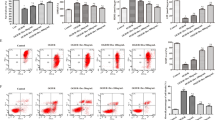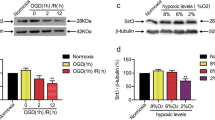Abstract
Objective
To explore the neuroprotective effects of baicalin against hypoxia and glucose deprivationreperfusion (OGD/RO)-induced injury in SH-SY5Y cells.
Methods
SH-SY5Y cells were divided into a control group, a OGD/RO group, which was subject to OGD/RO induction; and 3 baicalin groups subject to baicalin (1, 5, 25 μmol/L) for 2 h before induction of OGD/RO (low-, medium-, and high-dose baicalin groups). Cell viability was detected by thiazolyl blue tetrazolium bromide (MTT) assay and flow cytometric analysis was used to detect cell apoptosis. Real-time polymerase chain reaction was performed to determine the mRNA expression of caspase-3 gene. Western blot analysis was conducted to determine the expression of nuclear factor (NF)-κB and N-methyl-daspartic acid receptor-1 (NMDAR1).
Results
Baicalin could significantly attenuate OGD/RO mediated apoptotic cell death in SH-SY5Y cells; the apoptosis rates in the low-, medium- and high-dose groups were 12.1%, 7.9%, and 5.4%, respectively. Western blot and real-time PCR analysis revealed that significant decrease in caspase-3 expression in the baicalin group compared with the OGD/RO group (P<0.01). Additionally, down-regulation of NF-κB and NMDAR1 was observed in the baicalin group compared with those obtained from the OGD/RO group. Compared with the low-dose baicalin group, remarkable decrease was noted in the medium- and high-dose groups (P<0.01).
Conclusion
Baicalin pre-treatment attenuates brain ischemia reperfusion injury by suppressing cellular apoptosis.
Similar content being viewed by others
References
Winters L, Winters T, Gorup D, Mitrecic D, Curlin M, Križ J, et al. Expression analysis of genes involved in TLR2-related signaling pathway: inflammation and apoptosis after ischemic brain injury. Neuroscience 2013;238:87–96.
Ohshima M, Tsuji M, Taguchi A, Kasahara Y, Ikeda T. Cerebral blood flow during reperfusion predicts later brain damage in a mouse and a rat model of neonatal hypoxic-ischemic encephalopathy. Exp Neurol 2012;233:481–489.
Chen X, Deng A, Zhou T, Ding F. Pretreatment with 2-(4-methoxyphenyl)ethyl-2-acetamido-2-deoxy-b-D-pyranoside attenuates cerebral ischemia/reperfusion-induced injury in vitro and in vivo. PLoS One 2014;9:e100126.
Liu RL, Xiong QJ, Shu Q, Wu WN, Cheng J, Fu H, et al. Hyperoside protects cortical neurons from oxygen-glucose deprivation-reperfusion induced injury via nitric oxide signal pathway. Brain Res 2012;1469:164–173.
Jung SH, Kang KD, Ji D, Fawcett RJ, Safa R, Kamalden TA, et al. The flavonoid baicalin counteracts ischemic and oxidative insults to retinal cells and lipid peroxidation to brain membranes. Neurochem Int 2008;53:325–337.
Lin L, Wu XD, Davey AK, Wang J. The anti-inflammatory effect of baicalin on hypoxia/reoxygenation and TNF-alpha induced injury in cultural rat cardi-omyocytes. Phytother Res 2010;24:429–437.
Moghaddam E, Teoh BT, Sam SS, Lani R, Hassandarvish P, Chik Z, et al. Baicalin, a metabolite of baicalein with antiviral activity against dengue virus. Sci Rep 2014;4:5452.
Li-Weber M. New therapeutic aspects of flavones: the anticancer properties of Scutellaria and its main active constituents wogonin, baicalein and baicalin. Cancer Treatment Reviews 2009;35:57–68.
Zhou QB, Duan CZ, Jia Q, Liu P, Li LY. Baicalin attenuates focal cerebral ischemic reperfusion injury by inhibition of protease-activated receptor-1 and apoptosis. Chin J Integr Med 2014;20:116–122.
Gong WY, Wu JF, Liu BJ, Zhang HY, Cao YX, Sun J, et al. Flavonoid components in Scutellaria baicalensis inhibit nicotineinduced proliferation, metastasis and lung cancer-associated inflammation in vitro. Int J Oncol 2014;44:1561–1570.
Fallarini S, Miglio G, Paoletti T, Minassi A, Amoruso A, Bardelli C, et al. Clovamide and rosmarinic acid induce neuroprotective effects in in vitro models of neuronal death. Br J Pharmacol 2009;157:1072–1084.
Song JX, Choi MY, Wong KC, Chung WW, Sze SC, Ng TB, et al. Baicalin antagonizes rotenone-induced apoptosis dopaminergic SH-SY5Y cells related to Parkinsonism. Chin Med 2012;7:1.
Qi HY, Li L, Yu J, Chen L, Huang YL, Ning L, et al. Proteomic identification of Nrf2 mediated phase II enzymes critical for protection of Tao Hong Si Wu Decoction against oxygen glucose deprivation injury in PC12 cells. Evid Based Complement Alternat Med 2014;2014:945814.
Chen B, Cheng Q, Yang K, Lyden PD. Thrombin mediates severe neurovascular injury during ischemia. Stroke 2010;41:2348–2352.
Kilicdag H, Daglioglu K, Erdogan S, Guzel A, Sencar L, Polat S, et al. The effect of levetiracetam on neuronal apoptosis in neonatal rat model of hypoxic ischemic brain injury. Early Hum Dev 2013;89:355–360.
Harukuni I, Bhardwaj A. Mechanisms of brain injury after global cerebral ischemia. Neurol Clin 2006;24:1–21.
Mahesh R, Jung HW, Han CH, Cho CW, Park YK. Joongpoongtang 05 (JP05) confers neuroprotection via antiapoptotic activities in Neuro-2a cells during oxygen-glucose deprivation and reperfusion. Toxicol In Vitro 2011;25:177–184.
Zhao Q, Zhang C, Wang X, Chen L, Ji H, Zhang Y, et al. (S)-ZJM-289, a nitric oxide-releasing derivative of 3-n-butylphthalide, protects against ischemic neuronal injury by attenuating mitochondrial dysfunction and associated cell death. Neurochem Int 2012;60:134–144.
Ueda S, Nakamura H, Masutani H, Sasada T, Takabayashi A, Yamaoka Y, et al. Baicalin induces apoptosis via mitochondrial pathway as prooxidant. Mol Immunol 2002;38:781–791.
Zhou QM, Wang S, Zhang H, Lu YY, Wang XF, Motoo Y, et al. The combination of baicalin and baicalein enhances apoptosis via the ERK/p38 MAPK pathway in human breast cancer cells. Pharmacol Sin 2009;30:1648–1658.
Susan LH, James CG, Roger S, Larry AD. Nuclear factor-κB and cell death after experimental intracerebral hemorrhage in rats. Stroke 1999;30:2472–2478.
Zhou QB, Jin YL, Jia Q, Zhang Y, Li LY, Liu P, et al. Baicalin attenuates brain edema in a rat model of intracerebral hemorrhage. Inflammation 2014;37:107–115.
Saad MA, Abdel Salam RM, Kenawy SA, Attia AS. Pinocembrin attenuates hippocampal inflammation, oxidative perturbations and apoptosis in a rat model of global cerebral ischemia reperfusion. Pharmacol Rep 2015;67:115–122.
Love S. Apoptos is and brain is chaemia. Prog Neuropsychopharmacol Biol Psychiatry 2003;27:267–282.
Broughton BR, Reutens DC, Sobey CG. Apoptotic mechanisms after cerebral ischemia. Stroke 2009;40:e331–e339.
Kucharczak J, Simmons MJ, Fan Y. To be or not to be: NF-κB is the answer role of Rel/NF-κB in the regulation of apoptosis. Oncogene 2003;22:8961–8982.
Clemens JA. Cerebral ischemia: gene activation, neuronal injury, and the protective role of antioxidants. Free Radic Biol Med 2000;28:1526–1531.
Lu M, Tang F, Zhang J, Luan A, Mei M, Xu C, et al. Astragaloside ? attenuates injury caused by myocardial ischemia/reperfusion in rats via regulation of toll-Like receptor 4/nuclea factor-κB signaling pathway. Phytother Res 2015;10:5297.
Lin M, Li L, Li L, Pokhrel G, Qi G, Rong R, et al. The protective effect of baicalin against renal ischemia-reperfusion injury through inhibition of inflammation and apoptosis. BMC Complement Altern Med 2014;14:19.
Paul P, de Belleroche J. Experimental approaches for elucidating co-agonist regulation of NMDA receptor in motor neurons: therapeutic implications foramyotrophic lateral sclerosis (ALS). J Pharm Biomed Anal 2015;116:2–6.
Dai SH, Qin N, Chen T, Luo P, Zhang L, Rao W, et al. Activation of mGluR5 attenuates NMDA-induced neurotoxicity through disruption of the NMDAR-PSD-95 complex and preservation of mitochondrial function in differentiated PC12 cells. Int J Mol Sci 2014;15:10892–10907.
Kajta M, Lason W, Kupiec T. Effects of estrone on N-methyl-Daspartic acid- and staurosporine-induced changes in caspase- 3-like protease activity and lactate dehydrogenase-release: time- and tissue-dependent effects in neuronal primary cultures. Neuroscience 2004;123:515–526.
Kajta M, Trotter A, Lason W, Beyer C. Effect of NMDA on staurosporine-induced activation of caspase-3 and LDH release in mouse neocortical and hippocampal cells. Brain Res Dev Brain Res 2005;160:40–52.
Author information
Authors and Affiliations
Corresponding author
Additional information
Supported by Seed Fund of the 2nd Hospital of Shandong University (No. S2013010002).
Rights and permissions
About this article
Cite this article
Zhou, Qb., Ju, Xn., Wang, Xy. et al. Pretreatment with baicalin attenuates hypoxia and glucose deprivation-induced injury in SH-SY5Y cells. Chin. J. Integr. Med. 22, 201–206 (2016). https://doi.org/10.1007/s11655-015-2326-8
Received:
Published:
Issue Date:
DOI: https://doi.org/10.1007/s11655-015-2326-8




